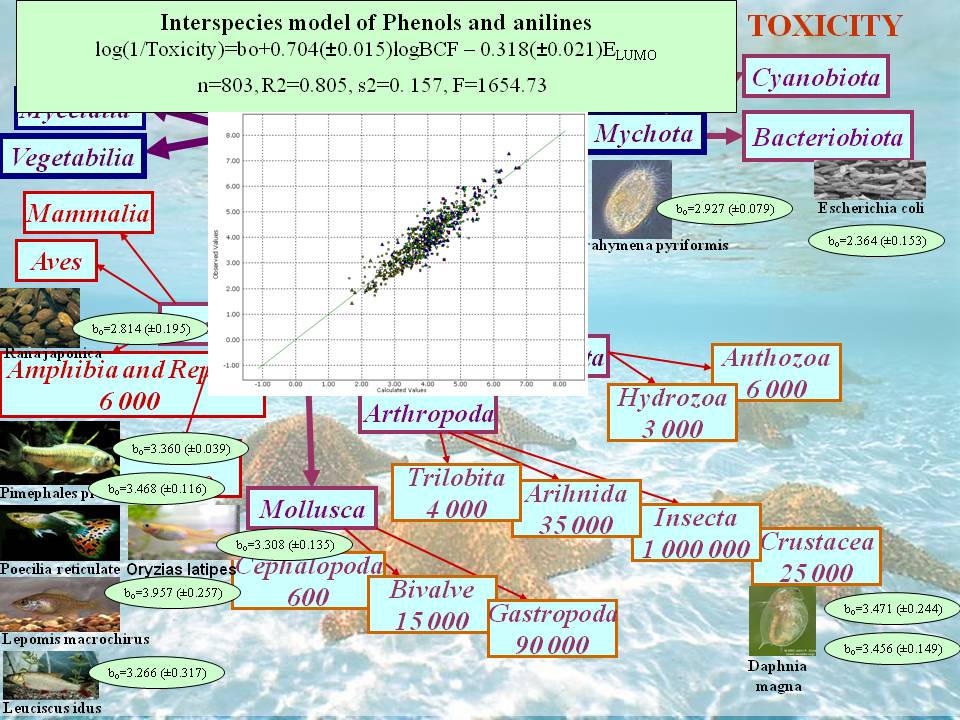Vibrio fisheri pT5
Endpoint
The acute aquatic toxicity model predicts the concentration required to elicit a 50% reduction in light emission of Vibrio fisheri (pT5) by chemicals within a designated period.
Data
The training set consists of pT5 values for 247 chemicals [1-11]:
- Test duration - 5 minutes,
- Test species - Vibrio fisheri (heterotrophic gram-negative bacteria).
The tested chemicals belong to the following categories:
- Narcotic toxicants - 136 chemicals,
- Reactive unspecified chemicals - 97 chemicals.
Model
The organism response to the presence of toxicant in the environment is considered as a consequence of the combined influence of two different processes: uptake of the chemical into the biophase and interaction with the site of action [12]. In the present model, the uptake is modeled by maximum potential of the toxicant to bioconcentrate in the fish, while the interaction of chemicals is explained by descriptors assessing the electrophilic character of the molecule [13]. Such descriptors could include the energy of the lowest unoccupied molecular orbital, electronegativity, average or maximum superdelocalizability, maximum charge at non-hydrogen atom, etc. The following model was developed based on regression analysis of the data:
log 1/pT5 = 1.82(±0.17)+1.13(±0.08)logBCFmax -0.08(±0.06) ELUMO
where BCFMax is the maximum bioconcentration factor [14], and ELUMO is the energy of the lowest unoccupied molecular orbital. For the reactive unspecified chemicals, only the minimum toxicity is determined based on the model for narcotic chemicals (i.e., log 1/EC50 ≥ log 1/EC50 of narcotics).
Domain
The stepwise approach [15] was used to define the applicability domain of the model. It consists of the following sub-domain levels:
- General parametric requirements - includes ranges of variation of log KOW and MW,
- Structural domain - based on atom-centered fragments (ACFs).
A chemical is considered In Domain if its log KOW and MW are within the specified ranges and its ACFs are presented in the training chemicals. The information implemented in the applicability domain is extracted from the correctly predicted training chemicals used to build the model and in this respect the applicability domain determines practically the interpolation space of the model.
Statistics
The precision of the regression model is characterized by the following estimates:
- 95% Confidence intervals of model parameters,
- Coefficient of determination R2 = 0.70,
- Mean squared error (estimate of error variance) s2 = 0.55,
- F value = 155.88,
- Number of chemicals, n = 135.
References
1. Gunatilleka AD, Poole CF. 2000. The Royal Society of
Chemistry 125: 127-132.
Estimating environmentally important properties of chemicals from
the chemical structure - Erik Furusjo, Magnus Andersson, Magnus
Rahmberg, Anders Svenson - Report B1517.
2. Jaworska JS, Schultz TW. 1994. Mechanism-based comparisons of
acute toxicities elicited by industrial organic chemicals in
procaryotic and eucaryotic systems. Ecotoxicol Environ Saf.
29(2):200-13.
3. Schultz TW, Cronin MTD. 1997. Quantitative structure-activity
relationships for weak acid respiratory uncouplers to Vibrio
fisheri. Environ. Toxicol. Chemistry 16: 357-360.
4. Warne MA, Boyd EM, Meharg AA, Osborn D, Killham K, Lindon JC,
Nicholson JK. 1999. Quantitative structure-toxicity relationships
for chlorophenols to bioluminescent lux-marked bacteria using
atom-based semi-empirical molecular-orbital descriptors. SAR/QSAR
Environ. Resear. 10: 473-495.
6. Cronin MTD, Bowers GS, Sinks GD, Schultz TW. 2000.
Structure-Toxicity relationships for Aliphatic Compounds
Encompassing a Variety of Mechanisms of Toxic Action to Vibrio
fischeri. SAR/QSAR Environ. Research. 11: 301-312.
7. Zhao YH, Ji GD, Cronin MTD, Dearden JC. 1998. QSAR study of the
toxicity of benzoic acids to Vibrio fischeri, Daphnia magna and
carp. The Science of the Total Environment 216: 205-215.
8. Schuurmann G. 1998. Ecotoxic Modes of Action of Chemical
Substances. 22.
9. Cronin MTD, Schultz TW. 1998. Structure-toxicity relationships
for three mechanisms of action of toxicity to Vibrio fischeri.
Ecotoxicol. Envronmen Safety 39: 65-69.
10. Cronin MTD, Schultz TW. 1997. Validation of Vibrio fischeri
acute toxicity data: mechanism of action-based QSARs for non-polar
narcotics and polar narcotic phenols. The Science of the Total
Environment 204: 75-88.
11. Zhao YH, Cronin MTD, Dearden JC. 1998. Quantitative
Structure-Activity Relationships of Chemicals Acting by Non-polar
Narcosis- Theoretical Considerations. Quant. Struct.-Act. Relat.
17: 131-138..
12. J.W. McFarland, J. Med. Chem. 13 (1970) 1092-1196.
13. S.D. Dimitrov, O.G. Mekenyan, G.D. Sinks, T.W. Schultz,
Journal of Molecular Structure (Theochem), 622 (2003) 63-70.
14. S. Dimitrov, N. Dimitrova, D. Georgieva, K. Vasilev, T.
Hatfield, J. Straka, O. Mekenyan, SAR and QSAR in Environmental
Research, 23 (2012) 17-36.
15. S. Dimitrov, G. Dimitrova, T. Pavlov, N. Dimitrova, G.
Patlevisz, J. Niemela and O. Mekenyan, J. Chem. Inf. Model. 45
(2005) 839-849.



